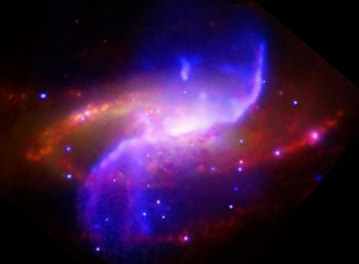Messier 106 is an elongated spiral galaxy, seen by us at a low angle, in the constellation of Canes Venatici (CANE-eez ven-AT-ih-sigh, the hunting dogs). It’s about 25 million light years away, give or take. That may sound far – 250 million trillion kilometers! – but for Hubble, that’s considered close. So if you take a stack of Hubble images of M106 and put them together, as amateur astronomer Andre vd Hoeven did, you get a lovely picture it!
[Click to galactinate and get access to a zoomable version – and you want to. I shrank the image considerably to get it to fit here. (UPDATE: there’s a HUGE version at Flickr.)]
M106 looks a bit odd to my eye. The overall structure is pretty typical for a two-armed spiral seen at this low angle, but still… those red spots mark the location of busy star formation. The hot young stars heat up their surrounding gas, and the hydrogen in them reacts by glowing. Usually you see star formation that intense over a large region of the galaxy, or a small region, but not somewhere in between like this.
 Not being familiar with the galaxy, I looked it up, and found the image inset here (which I’ve rotated to better match the Hubble image above). Right away we see something really weird: there are two more arms invisible in the Hubble shot!
Not being familiar with the galaxy, I looked it up, and found the image inset here (which I’ve rotated to better match the Hubble image above). Right away we see something really weird: there are two more arms invisible in the Hubble shot!
What the what?
The inset picture is a combination from a lot of telescopes and wavelengths: visible light (displayed as gold), infrared (red), radio (purple) and X-ray (blue). The visible and IR line up well with Hubble’s view, but the radio and X-ray clearly show those extra arms. X-rays are emitted by very hot gas – like, million degrees hot – and radio is emitted by gas with a strong magnetic field permeating it. That’s a hint about what’s going on. Another is that the core of the galaxy is very bright, glowing more fiercely than you’d expect from a normal galaxy.
That adds up to one thing: an actively feeding black hole in the galaxy’s heart. And it’s big: about 40 million times the mass of the Sun. Material from the galaxy is falling onto the black hole, and piling into a huge disk just outside the Final Plunge. This disk is incredibly hot, and for reasons still not entirely understood (but which involve intense magnetic fields) powers twin beams of energy and matter which blast out at high speed in opposite direction. These beams are slamming into and heating up the gas in the galaxy, and that’s what’s lighting up those extra arms. The beams are cone-shaped (think beams from a light house), which is why we only see some of that gas lit up.
Weirdly, the beams are blasting through the disk of the greater galaxy. Usually, the disk of the black hole is roughly aligned with the exterior galaxy itself, so the beams travel “up and down”, right out of the galaxy, but clearly that’s not the case here! Also, judging from the power in those beams, if they were aimed at us the core of that galaxy would be really bright, and M106 would be a heckuva lot more famous than it already is. I wonder if it would be naked eye visible? It’s possible.
Funny. There’s hardly a hint of all that incredible energy blasting out, all that drama, in the Hubble image. As detailed and high-resolution as it is, it shows we still need as many eyes on the sky as can muster if we really want to uncover the secrets of the Universe.
Image credits: Hubble: Andre vd Hoeven & Adrian Zsilavec and Michelle Qualls/Adam Block/NOAO/AURA/NSF & enhanced with a ground-based image by Adam Block; X-ray:NASA/CXC/Univ. of Maryland/A.S. Wilson et al./Optical: Pal.Obs. DSS/IR: NASA/JPL-Caltech/Radio: NRAO/AUI/NSF
Related Posts:
- Desktop Project Part 22: A black hole belches out a hurricane
- A weird and lovely spiral for your weird and lovely Monday
- The lovely faces and dark hearts of two galaxies
- S marks the spot